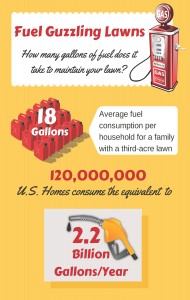Winter is the season we think of when it comes to fuel usage, but a surprising amount is used in summer lawn and garden maintenance as well. Paul Tukey, the author of the Organic Lawn Care Manual, has done the math. He claims that the average fuel consumption per household for a family with a third-acre lawn is equivalent to 18 gallons of gasoline!
How fuel is used
Tukey’s estimate assumes that 5 gallons of gasoline will be used to power a gas mower. But mowing is not the only way we burn fuel in the backyard. Conventional fertilizers require a great deal of heat to synthesize atmospheric nitrogen and hydrogen into ammonia. He says “The amount of natural gas required to make approximately 200 bags of lawn fertilizer would heat your home for a year. Each 40-pound bag contains the fossil fuel equivalent of approximately 2.5 to 3 gallons of gasoline.”
If you live in an area, such as the West where water must be pumped long distances, add the equivalent of another 5 gallons of fuel, says Tukey. It requires energy to power those pumps!
Powering blowers to sweep up clippings, leaves, and debris account for an addition gallon of fuel.
“At U.S. 120,000,000 households,” Tukey says, “that’s the equivalent of almost 2.2 billion gallons of fuel used on lawn care each year.”
Tukey doesn’t even include an amount for fuel waste, such as when gas left in outdoor equipment tanks goes bad and must be turned over to a hazardous waste recycling center. Nor does he mention oil needed for lubrication of engines that power many pieces of outdoor power equipment. Many herbicides and pesticides, often used in lawn care, are also made with petrochemicals.
How to maintain a yard and use less fuel
In the area of mowing, reducing your lawn size is the single most effective way to reduce landscaping fuel usage. See my recent post, “Downsize Your Lawn to Save Energy” to read about how to do it.
Your choice of mowing equipment will also have an impact. With a smaller lawn, you may be able to get the job done with a muscle-powered push mower. If you need a power assist, consider an electric mower. Battery-powered models eliminate the nuisance of having to keep the power cord from getting snipped by the mower blade! I’ve used batter-powered mowers for the past 15 years. The first lasted 11 years, with the only maintenance being blade sharpening and replacing the battery once. The second model, from Toro, has served for the past 4 years without a problem. Battery-powered yard equipment use about 30 percent less energy than gas-powered models – and are much quieter. Look for the Energy Star label before you buy.
Reduce your reliance on conventional fertilizers and opt for organic substitutes, including bone and blood meal, and composted manures. Be aware, however, that most organic fertilizers do not have the same punch as the manufactured fertilizers. Reduce your requirements by leaving clippings on your lawn and setting blade height to 3 inches. Taller grass requires less fertilizer because it doesn’t need to continually regenerate itself. Encouraging clover in the lawn – even seeding for it – will also help.








